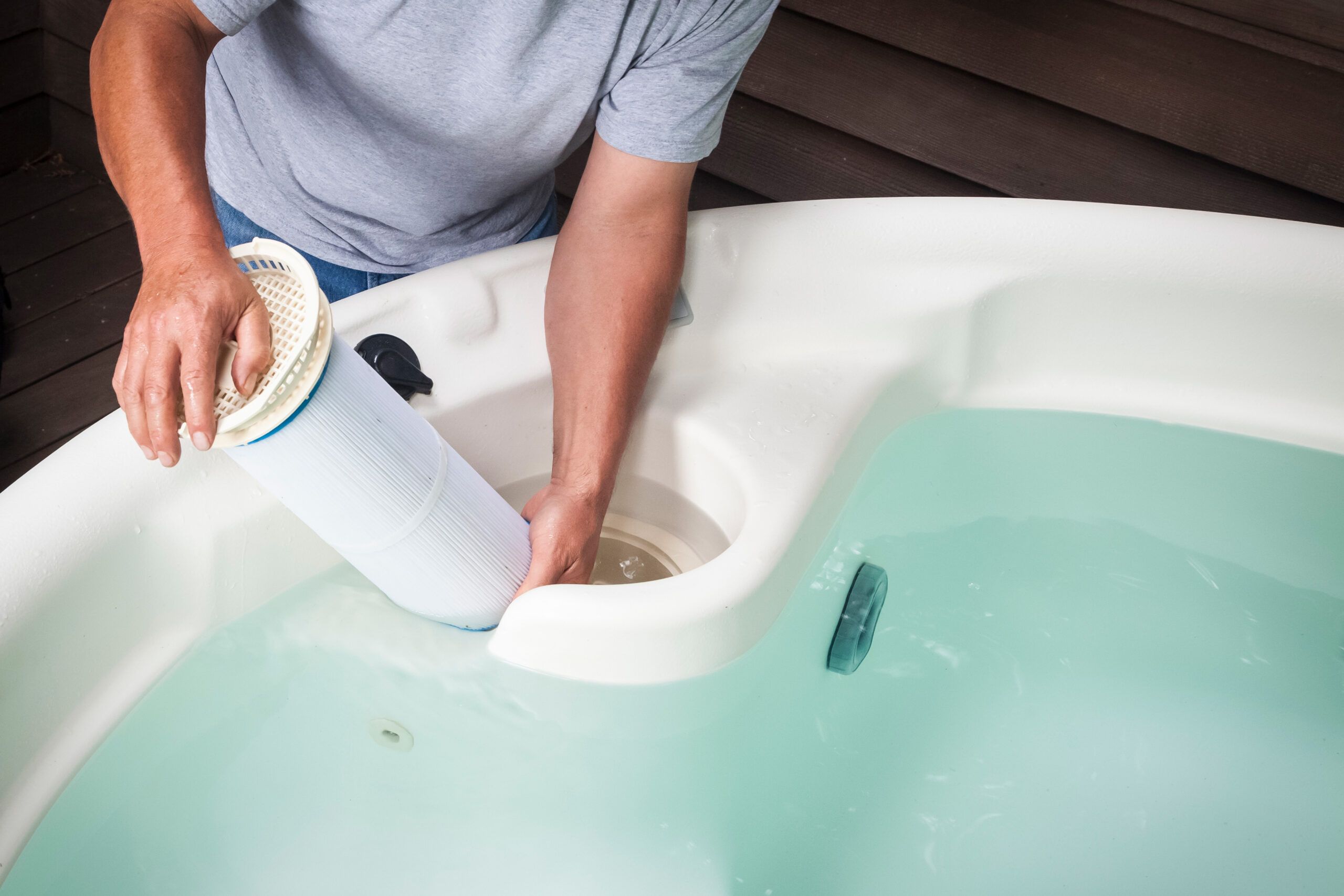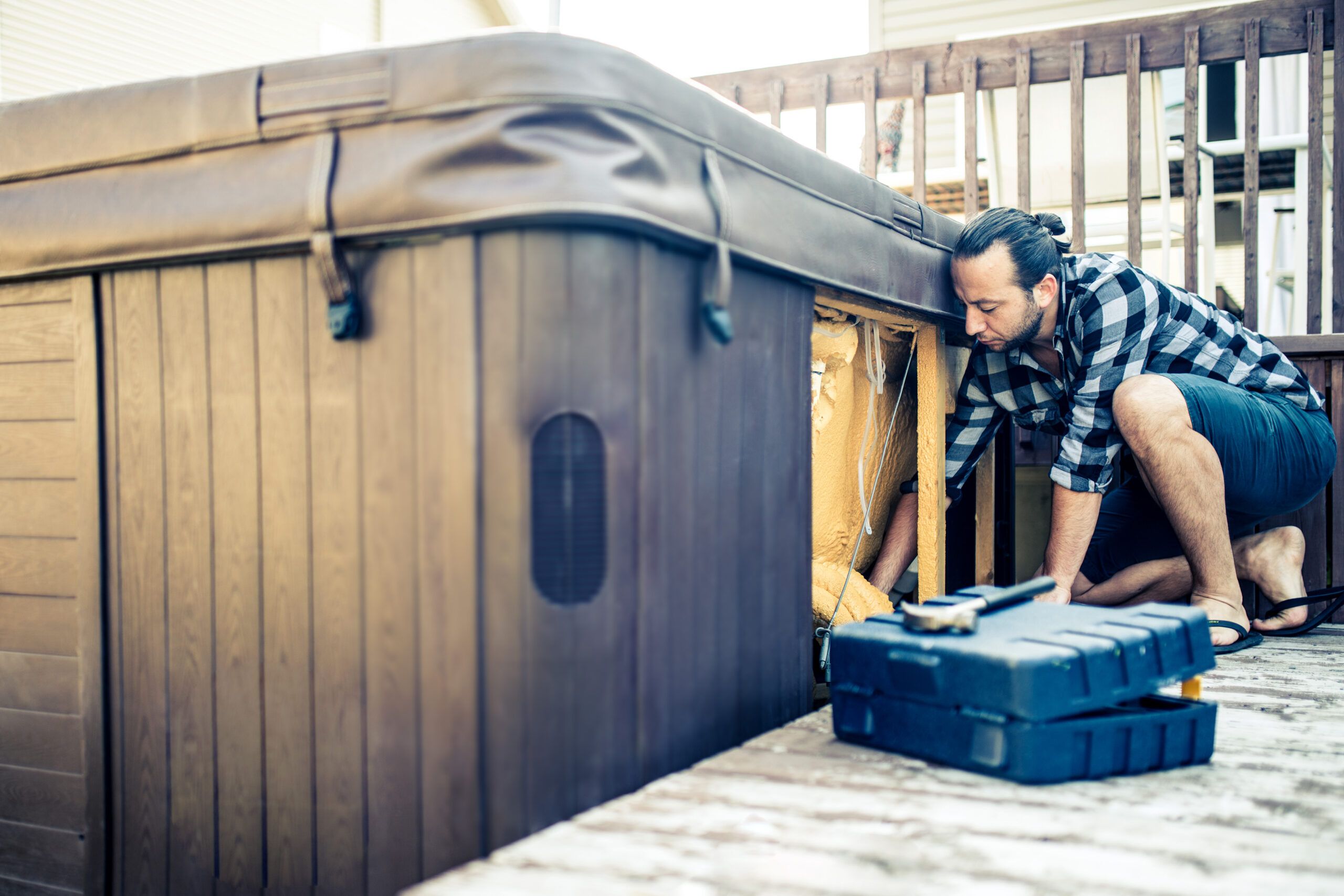Hot tubs offer a luxurious way to relax and unwind, but a leak can quickly turn your backyard oasis into a headache. Fortunately, many hot tub leaks are fixable with the right knowledge and tools. This guide will walk you through the process of identifying, locating, and repairing hot tub leaks with no need to call in the pros.
Common Causes of Hot Tub Leaks
Hot tub leaks can happen for many reasons. Here are some common reasons homeowners find their hot tubs leaking:
- Age and wear: Over time, seals, gaskets, and pipes can deteriorate.
- Chemical imbalance: Incorrect water chemistry can cause corrosion and leaks.
- Freeze damage: Water expansion during freezing can crack pipes and fittings.
- Improper installation: Poorly fitted components can lead to leaks.
- Physical damage: Impacts or stress on the tub structure can create cracks.
Essential Tools and Materials for Hot Tub Leak Repair
Before starting your repair, gather these tools and materials:
- Flashlight
- Hacksaw
- Heat gun
- Leak-stopper liquid
- Leak detection dye
- O-rings
- PVC pipe or hose (if needed)
- Screwdriver
- Spa fittings and couplings
- Spackle knife or putty knife
- Spray foam insulation
- Tubing cutter
- Various gaskets
- Water pump pliers
Locating the Source of Your Hot Tub Leak
Often, the most challenging part of the repair process is finding the exact location of a leak. Some leaks only happen when the pump is running, so you may need to perform tests with the system both on and off.
Start with a thorough visual inspection:
- Turn off the hot tub and allow the water to settle.
- Examine the exterior for wet spots or drips.
- Check around fittings, jets, and the pump area.
- Look for cracks in the shell or visible damage to pipes.

Fixing Small Leaks in Your Hot Tub
There’s a chance your leak is small and easy to fix, so don’t start ripping things out from under your hot tub without checking for a small leak first. Pinholes and small cracks caused by age, cold temperatures, or manufacturing flaws are sometimes conquerable with a fix in a bottle. For that reason, it’s worth trying these steps first:
- Remove the hot tub filters.
- With the pump running, follow the leak-sealer manufacturer’s instructions and pour a quarter to a third of the bottle (depending on bottle size) directly into the filter area where your suction intake is located.
- Take note of the water level.
- Allow the hot tub to run for 24 hours.
- Check the water level to see if the leak has stopped.
If the water loss slows but doesn’t stop completely, repeat the process with more sealant. If it stops completely, you’ve fixed your leak.
For visible small cracks or pinholes, here’s what we recommend:
- Drain the hot tub below the leak area.
- Clean and dry the affected area thoroughly.
- Apply a specialized waterproof, marine-grade epoxy or sealant.
- Allow the repair to cure fully before refilling the tub.
Dealing With Hot Tub Insulation Leaks

One of the most challenging leaks to locate is one coming from a jet, pipe, or hose buried inside the hot tub’s insulation. It’ll take a bit of detective work.
Follow these steps to find leaks hidden in the insulation:
- Remove as many access panels as possible.
- With as many access panels removed as possible, allow the hot tub to run like normal.
- Lying on the ground, use a flashlight to detect any drips or wet foam. This will give you a general idea of the leak’s location.
- Once you’ve narrowed down the area, carefully cut away foam to expose the leak.
- Depending on which component is leaking, follow the specific steps we’ve outlined below.
When you’re working with insulation, use a spackle knife or similar tool to cut away any wet foam carefully. Remove only as much foam as necessary to access the leak. After repairing the leak, replace the insulation with spray foam. Allow the new foam to cure fully before closing up the access panels.
Repairing Specific Hot Tub Components
Different components of your hot tub may require specific repair techniques. Here’s how to address common problem areas.
Fixing Pump and Heater Leaks
A common area for leaks is on either side of the pump or heater. To access the area, you’ll have to remove the hot tub’s side panels. Typically, this just takes loosening a few hand-turned fasteners and some shuffling. With the panel removed, take a look at the pump and heater. If water is dripping, spraying, or puddling around the pump or heater, you’ve found your leak. Usually, cracked fittings or worn-out O-rings are to blame. Follow these steps to remedy the problem:
- Power off the hot tub and close the gate valves on either side of the pump.
- Use a screwdriver and pump pliers to remove any leaky fittings and replace them with new ones.
- Check and replace O-rings if necessary.
- Reassemble the components, open the gate valves, turn the pump on, and test for leaks.
Addressing Light Fixture Leaks
Another common area for leaks is the spa light. If the water level drops to around the height of the light, this could be your problem. The leak can come from a crack in the light fixture itself or the gasket behind it. Light fixture leaks can be tricky but are often fixable. Here’s how:
- Turn off the power and remove the side panels to access the light.
- From under the hot tub, check each light for water to locate the suspected leaking light. If you can’t tell, remove the next panel and continue checking the lights for moisture.
- Remove the leaking bulb and the plastic retaining nut holding the fixture in place. You may need to cut away insulation foam.
- Push the lens out from the back into the tub.
- Depending on the damage, you can replace the entire fixture or just the gasket. To reinstall a new light, simply clean any gasket residue from the inside, slide the new gasket onto the new lens, place the lens into the hole from inside the tub, and tighten the plastic retaining nut in the access area.
- Reassemble in reverse order, ensuring a tight seal.
Spa lights come in different styles and sizes, so it’s best to take the fixture to a pool supply store and allow them to either match it with a new light or provide a replacement gasket. Note that we recommend replacing all of your lights at once. They’re most likely the same age, and others will leak soon if one already has.
Dealing With Jet Leaks
If the leak is coming from a jet, you’ll need to follow this process:
- Using the pump pliers, squeeze the metal tabs on the clamp and slide it to the side. If the hoses are difficult to remove, you can use a heat gun to warm them up a bit—but be careful not to melt them.
- Remove the plastic retaining nut that holds the jet in place.
- Replace the gasket or the whole jet if needed.
- To reinstall the jet, slide the gasket over the back of the jet, place it into the hole from the inside of the tub, and tighten down the plastic retaining nut from inside the access area.
- Reattach the hoses and slide the hose clamps back over the fittings.
- Once you test the repair by running the hot tub, cover the repair area with a can of spray foam.
Resolving Hose and Pipe Issues
If it’s a hose or pipe that’s leaking, first remove the foam to find the cracked section. Then try these steps:
- Using a tubing cutter or hacksaw, cut out the cracked section of pipe or hose. Get a replacement section of the same material and pick up a few couplings meant for PEX/PVC pipe or hose.
- Install the fittings onto the existing section of the hot tub and cut a replacement hose section to fit.
- Slide one end of the replacement into or over the fittings, depending on the type.
- Once you test the repair by running the hot tub, replace the insulation with a can of spray foam.
Your hot tub should be back up and running, leak-free. Finding and accessing the leak is almost always the hardest part of repairing a leaky hot tub, so take your time and be prepared to cut away a lot of foam. The end result is worth it.
Professional Hot Tub Leak Repair: When To Call an Expert
You can often fix hot tub leaks yourself, but some situations call for professional help. This is especially true when any of the following apply:
- You can’t locate the source of the leak.
- The leak is in a difficult-to-access area.
- Repairs involve complex electrical or plumbing work.
- The leak has caused significant damage to the tub structure.
- You’re not comfortable with the repair process.
Professional hot tub technicians have specialized tools and experience to handle complex leaks efficiently and safely. If you’re unsure about any aspect of the repair, we recommend consulting a professional to avoid potentially costly mistakes.

